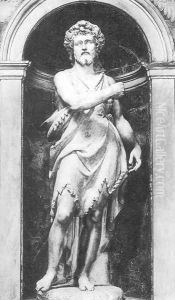Ambrogio Bonvicino Paintings
Ambrogio Bonvicino, also known as Ambrogio Buonvicino, was an Italian sculptor of the late Renaissance, active mainly in his native Lombardy, particularly around Brescia. Born around 1552, his exact birthplace is not well-documented, but his life and work were deeply intertwined with the artistic movements of the late 16th and early 17th centuries in Northern Italy. Bonvicino's contributions to art are often associated with the transition from the Renaissance to the early Baroque period, reflecting the evolving aesthetic preferences of his time.
Ambrogio Bonvicino's work is characterized by a blend of classical Renaissance elegance and the emerging dynamism of Baroque sculpture. He was adept in working with marble and bronze, producing both religious and secular pieces that were celebrated for their detailed execution and expressive figures. His sculptures often depicted themes from mythology, Christianity, and historical subjects, showcasing his versatility and deep understanding of human anatomy and emotion.
Among his notable works is the bronze statue of Pope Paul V, located in Brescia, which exemplifies his mastery of bronze casting and his ability to convey authority and spirituality through sculpture. Bonvicino also contributed to the decoration of various churches and public buildings in Brescia and its surroundings, leaving a lasting legacy in the region's cultural heritage.
Despite his contributions to Italian sculpture, Ambrogio Bonvicino's name is not as widely recognized as some of his contemporaries. However, his work continues to be studied and admired by art historians and enthusiasts for its technical skill and aesthetic beauty. Bonvicino's sculptures not only reflect the artistic trends of his time but also provide insight into the cultural and religious milieu of late Renaissance Italy. He passed away in 1622, leaving behind a body of work that remains influential in the study of Italian Renaissance and early Baroque art.
